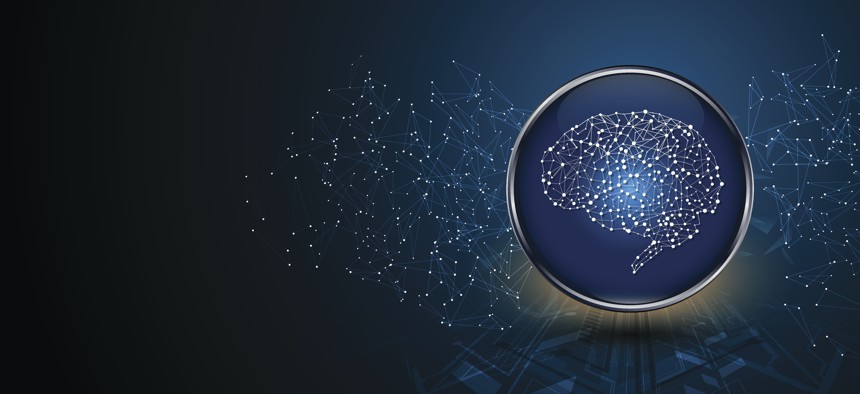sponsor content What's this?

Augmented Intelligence Requires Human Direction
The strengths of human-machine collaboration can be more effective than either force acting on its own.
Presented by IBM
Today, the many manifestations of artificial intelligence (AI) touch almost every part of our lives. Citizens often do not make the connection between AI and the amazing new products and services broadly available on the market. But the impact of AI goes far beyond innovative consumer products. Historically, humans exclusively created and delivered knowledge. Now, in the era of cognitive computing, machines have the potential to help people unlock knowledge and insights from massive volumes of data.
This combination of human and machine makes AI both powerful and transformative. It’s why IBM refers to AI as augmented—not artificial—intelligence. This is a critical difference. IBM believes in systems that can enhance and scale human expertise, rather than those that attempt to replicate human cognition.
IBM has been researching, developing and investing in AI technology and cognitive systems for more than 50 years. Cognitive systems understand imagery, language and unstructured data. They reason by grasping underlying concepts, forming hypotheses, and inferring and extracting ideas. They learn by developing and sharpening expertise with each new data point, interaction and outcome. And they interact with people in a natural way that allows cognitive solutions to see, hear and talk.
In October, the White House and the National Science and Technology Council’s Subcommittee on Machine Learning and Artificial Intelligence released a report titled “Preparing for the Future of Artificial Intelligence.”
There are great examples in the report about how the strengths of the human-machine collaboration can be more effective than either one operating alone. In chess, a weaker computer can beat a stronger one if the weaker one is given a human partner—and it’s true even though top computers are much stronger players than any human.
The report also calls out radiology. In one recent study, given images of lymph node cells, and asked to determine whether the cells contained cancer, an AI-based approach had a 7.5 percent error rate, and a human pathologist had a 3.5 percent error rate. But in combining AI and human input, the error rate lowered to 0.5 percent—an 85 percent reduction in error.
IBM is working with 20 top cancer institutes whose researchers and doctors are teaching IBM’s Watson about cancer. The amount of data on cancer diagnoses, treatments and protocols, clinical trials and research is staggering; about 8,000 new research papers are published daily. No doctor could keep up.
At the University of North Carolina Chapel Hill’s Lineberger Cancer Center, Watson is helping doctors come up with treatment options for patients who have failed standard therapies. Watson read volumes of medical literature, including about 25 million research papers and scanned the web for clinical trials. In approximately 30 percent of 1,000 cases, Watson uncovered treatment options that researchers otherwise would not have known about.
These examples illustrate perfectly what we mean by augmentation. Working in partnership with a cognitive assistant, a human professional can scale and extend his or her own expertise!
When human learning and machine processing are purposefully integrated, new capabilities are created that can solve a wide range of practical problems, boost productivity, foster innovation and lead to new discoveries across many industries.
Think about the opportunities—we can harness the intelligence of our most incredible thinkers to glean insights and revelations for generations. For the Department of Defense, we can design systems that take insights from the most brilliant generals and analysts and deliver that intelligence to the newest recruit.
The AI applications for defense are compelling:
- We can address fleet readiness and maintenance with cognitive systems that ingest maintenance records and manuals, read sensors and aggregate structured and unstructured data to provide real-time information about a fleet’s health and maintenance schedule.
- In cybersecurity, cognitive systems’ advantages include employing advanced machine learning to detect threat attack vectors and tradecraft; utilizing and deriving insights from non-traditional cyber sources to augment classic cyber detection and intelligence analysis; enabling intuitive, natural language interfaces from which CISOs and security operations center analysts can derive intelligence amplification; ingesting and analyzing massive amounts of real-time and historical data; and providing real-time recommendations and courses of action to remediate and minimize cyber attacks.
- Using imagery analysis, operators can analyze drone images in more detail than is possible with the human eye. The cognitively enabled Internet of Things can identify areas of concern—damage assessment, aircraft and terrain inspection, for example—so that users can determine whether, when and how to address them.
- And machine learning can provide unparalleled cognitive situational understanding, helping an operator outthink threats. For example, with notification of a high-value target, a cognitive solution takes data from many sources—including ISR assets—to find, fix and track the threat.
AI promises to amplify our nation’s agility and flexibility in an increasingly complex threat environment. Potential adversaries are working hard to chip away at U.S. technological superiority, demonstrated dramatically during the first Gulf war. Huge amounts of data are being produced daily, and much of it unstructured. AI can quickly make sense of this data tidal wave and power more informed decision-making.
Of course, the potential extends far beyond defense and security. IBM is now working with Harvard and Sesame Street on how to leverage augmented intelligence for education. Harvard and Sesame Street—that’s when I knew that augmented intelligence and cognitive learning had truly arrived! We all learn differently, via different modes and on different timelines. Cognitive computing allows for instruction tailored to the individual child; imagine the potential for education and training across the U.S. military and throughout the federal government!
Computing is no longer about coding. AI is delivering systems that can learn and increase functionality over time. Directed by human insight, cognitive systems will support the national defense by maintaining U.S. technological superiority and competitive advantage.